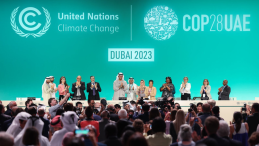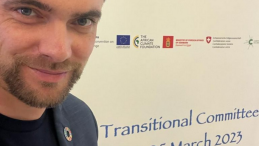Every April, the World Bank and IMF spring meetings, in Washington, D.C., convene decision makers - especially from Ministries of Finance - and experts to discuss ways to improve the global economy. In recent years, the focus of these meetings has increasingly also turned towards helping countries facing climate change.
Mobilizing climate finance and making the international financial system climate fit for purpose
Climate finance is a major enabler for climate action. The global green and resilience investment needs are enormous and growing, with USD 10 trillion required annually from 2030 onwards. A quarter of that needs to be mobilized for least developed countries and emerging economies.
Climate finance and international development finance is about realizing aspirations. It is crucial for the international system to scale up both concessional and non-concessional financing options for the upfront capital investment into the necessary energy transition and sustainable development, and to cover the increased investment and liquidity needs to enhance resilience and response to occurring and escalating climate impacts. COP 29, the climate summit hosted by Azerbaijan in November 2024, is expected to set the new bar for climate finance - a new qualitative collective climate finance goal. Delivering such a goal is a formidable political and technical challenge - including questions of political standing, scope, contributors, quality and transparency. Important to say that this is only one of several climate finance-related processes that need to make progress throughout the year to enable the necessary investments, financial flows and instruments needed for climate action.
Reform of the International Finance Architecture
Through the Bridgetown Initiative and the Accra Marrakesh Agenda, climate vulnerable countries have called for a global rehaul of the international finance architecture. The necessary reform steps include provision of new financial tools needed to address the growing challenges of climate change, including through access to liquidity and financial instruments to manage climate-related disasters. There is a need for a widespread adoption of climate-resilient and disaster-responsive debt clauses in providing fiscal flexibility during crises. Additionally, they call for increased investments in climate action, suggesting the expansion of lending ratios of multilateral development banks and public financing institutions for climate investments, and advocating for a systematic approach for debt-for-climate-action swaps. In addition, there needs to be a process to address unsustainable debt burden and revise sovereign debt analysis methodologies to account for climate risks. Reform steps are also required in addressing new sources for climate finance, including through international taxation, and finally, a reform to the governance of the international finance architecture to have more voting power for climate vulnerable countries.
Operationalize the Loss and Damage Fund
COP 28 operationalized the Loss and Damage Fund and decided on the World Bank as interim host. 2024 needs action on all sides: The Bank must still officially announce its willingness to host the Fund and capability to meet a number of conditions, which will require major innovation and reform within the Bank. The Loss and Damage Fund Board, which is meeting with significant delay for the first time at the end of April in UAE, has to provide answers for many open questions regarding, e.g. Governance and Operational Modalities of the Fund, and come up with a plan to take the Fund from millions to billions. Countries likewise need to prepare their national systems to address increasing losses and damages. Thorough action is needed with no time to waste on any side, as in 2023, every day was at least 1°C warmer than preindustrial levels and global disaster losses came to USD 250 billion at the very minimum.
What comes after the IMF and the World Bank Spring meetings?
The IMF and the World Bank’s Spring Meetings were only one milestone in a chain of important events and processes in 2024 related to climate and sustainable development finance. Discussions at the meeting focused largely on preparing the next concessional pledging round for the World Bank in autumn and concrete steps on reforming the World Bank and the IMF.
International finance institution reform is on the agenda for the UN Summit of Future and its Pact of the Future, which is culminating in September in New York. Similarly, the negotiation for the UN-led 4th Conference on Financing for Development will start shortly. Technical and political convenings take place throughout the year to prepare the discussion on the new qualitative, collective finance goal as the major decision at COP 29.
Given that components of a successful leap year for climate and sustainable development finance are scattered in several policy processes, a special focus will be on the G20, the convening of the largest economies in the world. The G20, led by Brazil in 2024, must play a central role in driving progress, with its key position as a global economic norm-setting body, to advance international cooperation on macroeconomic issues, especially regarding climate and development finance, and facilitate the necessary global consensus.




